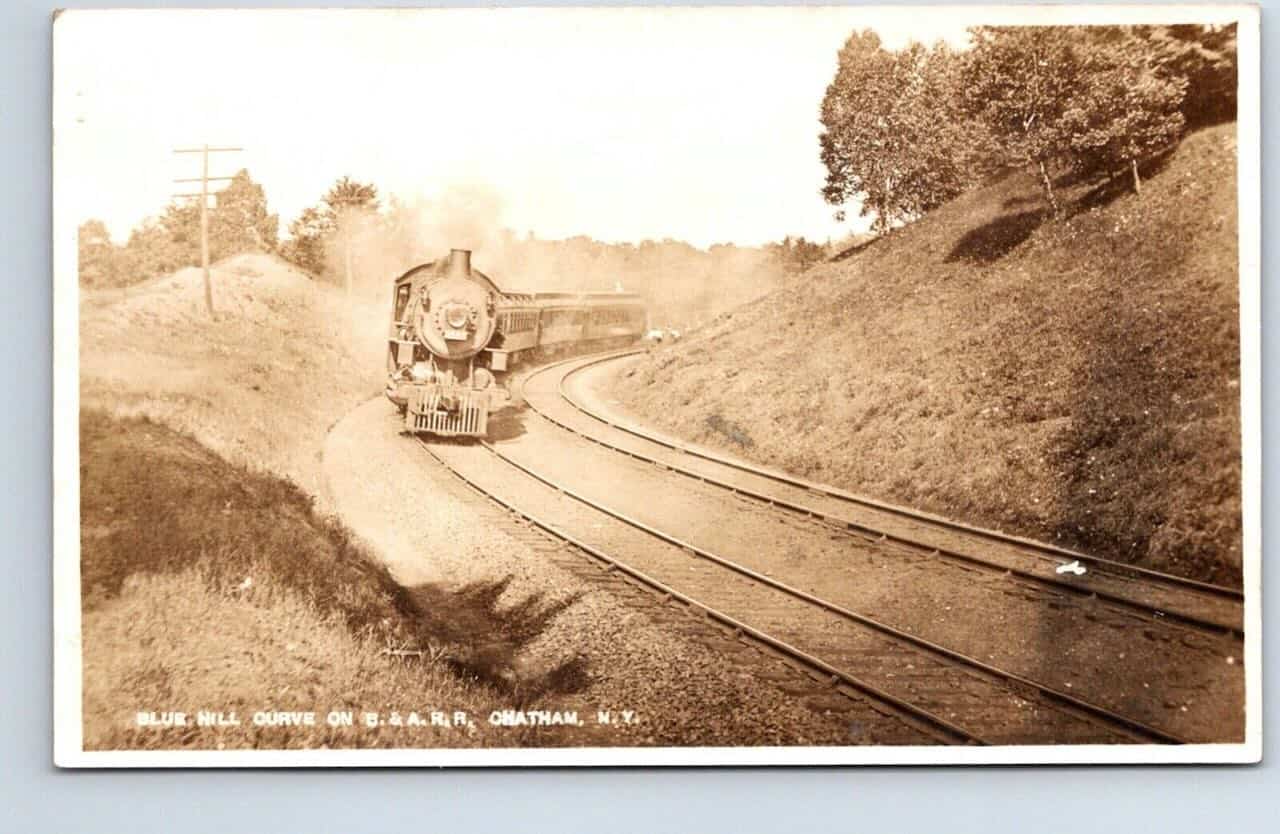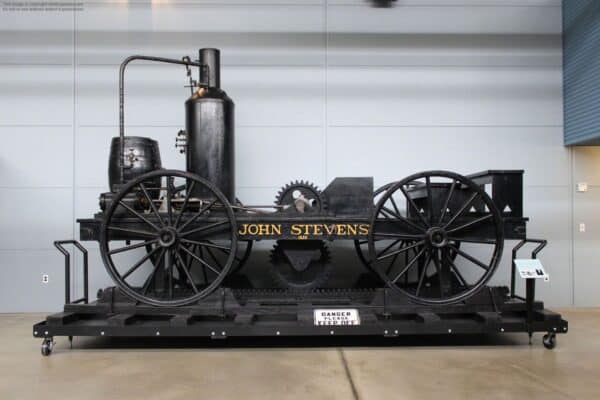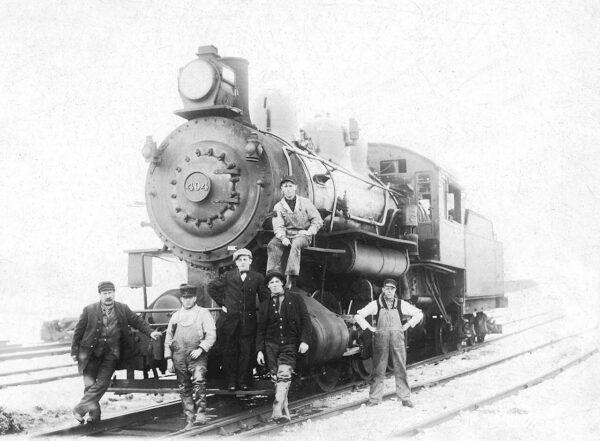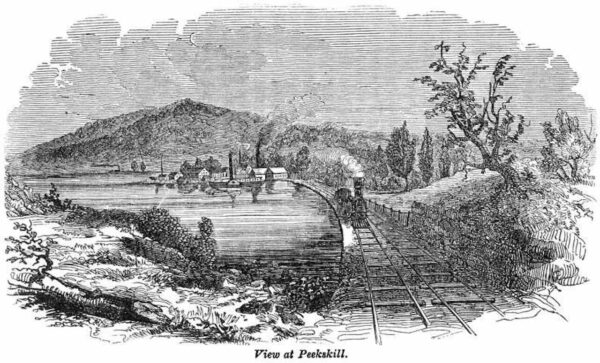Local History

Early railroading in the Hudson Valley
Above: Blue Hill Curve in Chatham, NY, is known as the sharpest curve on the Boston & Albany Railroad line.
It was half-past six in the morning when the first-ever train out of New York City was drawn by horse from Chambers Street to its starting point on 31st Street, on its way to stops at 152nd Street, Yonkers, Hastings, Dobbs Ferry, Tarrytown, Ossining, Peekskill, Cold Spring, Fishkill, New Hamburg, Poughkeepsie, Hyde Park, Rhinebeck, Oakhill, Hudson, Stuyvesant, Castleton, and last but not least, Albany at 11:35am.
The date of this inaugural trip of the Hudson River Railroad along its entire length was Wednesday, October 3, 1851.
Prior to that blessed event, the train could get itself by rail to Poughkeepsie, whereupon passengers would disembark and climb aboard a steamboat to get to Tivoli, where their train ride could continue. When that final 26 miles of track was complete, the way was clear for the full 143-mile trip.
How did things even progress to that point?
For years, a railroad line from New York City to Albany was considered a troublesome and ridiculously expensive proposition, if not altogether downright preposterous. One of the primary obstacles, which off the top of the head one might surmise was the terrain involved, was the predominant thinking of the time that train travel could hardly be expected to best that of steamboats. However, as it began to dawn on those who pondered such things, steamboats were great and all, yet then there was the matter of Mother Nature herself, as “during the winter months, averaging from 90 to 100 days of each year, the river is closed by the ice; and it proved a serious inconvenience, to say the least, for a channel, through which from one and a half to two millions of passengers were conveyed in the summer months, to be closed for the remainder of the year.”

A replica of John Stevens’ first steam carriage, which he developed in 1825. Credit: rgusrail.com.
To go forward, let’s first wander on back to 1826 and John Stevens, who, according to the Library of Congress, is “considered to be the father of American railroads. In 1826, Stevens demonstrated the feasibility of steam locomotion on a circular experimental track constructed on his estate in Hoboken, New Jersey, three years before George Stephenson perfected a practical steam locomotive in England.”
Now let’s leap ahead to 1831, when “on September 24, on what was known then as the Great Western Turnpike outside Albany, the first steam-powered passenger train in the country left from the spot now called the Point, at the juncture of Western and Madison avenues, on its first journey down 16 miles of track to Schenectady” at a top speed of 30 mph, notes the Upper Madison Group.
Organized in 1826, the company known as the Mohawk & Hudson R.R. Co., the first railroad chartered in the state, was responsible for that short journey, which sounds as though it may have been an uneventful excursion for the 15 passengers and countless rubberneckers along the route. But no.
“The chimney belched burning embers of pitch pine, ‘which showered down on the dignitaries.’ One rider noted that passengers had to raise umbrellas to protect themselves against the smoke and fire, but after one mile the umbrellas all burned and the passengers engaged in ‘a general melee. Each whipping his neighbor to put out the fire.’ Along the route, the train spooked the horses of those who came to watch, sending spectators tumbling in every direction.”
Connecting to the Big Apple
Skipping ahead to 1842, the New York and Albany Railroad was busy cranking up its efforts to connect the two cities. A somewhat cryptic travelogue of sorts popped up in the August 3, 1842, Morning Courier and New-York Enquirer, in which its author outlines what for all intents and purposes seems to be something of a celebratory/anticipatory trip – of a future completed rail line – from the Big Apple that wound up in Troy. Much of this trip comprised 44 miles of wagon rides, “in cars twenty-two, and on the steamboat six.”
“A delightful ride of sixteen miles brought us to North East, which is the highest summit of the road, and at this place again crossed over to the western side of the same beautiful valley, stopping at Cassaque for a short time,” states the writer. After a stop in Hillsdale for eats, the party proceeded to head “en route for Chatham, there to take the cars of the Western Rail Road for Greenbush.
“Up to Hillsdale, as far back as Owensville, our whole has been in sight nearly all the time of the Valley, bounded by high mountains, through which the road is intended to pass, and I cannot forbear repeating that of this entire distance, upwards of sixty miles, there is no portion of the road so difficult of construction, as have proved many miles on the best part of the Western Rail Road.”

Above: Train gang. Below: Peekskill view. Credit for these two photos and Blue Hill Curve are unknown but are public domain.
ROI and planning
By this time, observes the LOC, “Planning and construction of railroads in the United States [had] progressed rapidly and haphazardly, without direction or supervision from the states that granted charters to construct them. Before 1840 most surveys were made for short passenger lines, which proved to be financially unprofitable.” Not good. After all, the whole idea here was to return something in the way of profits to the many already well-heeled investors in this burgeoning new world of transportation and commerce.
Yet, as they say, the horse was out of the barn and the investors were seriously invested. Short rail lines had sprouted like crabgrass on the sixth fairway, although any sort of real planning, by states or otherwise, might best be described as haphazard, and these lines ultimately proved financially unprofitable. Overall, from 1826 to 1850, the NYS Legislature granted 151 charters with a total of 30 lines eventually developed, including the Albany to Buffalo route, composed of seven distinct companies that finished their work at different times.
In 1847, along came renowned civil engineer John B. Jervis (for whom Port Jervis is named), who surveyed a train line from Manhattan to Rensselaer – this would become the aforementioned portion of the Hudson River Railroad line that first extended from Manhattan to Poughkeepsie, then resume in Tivoli.
Curvature
According to Bradbury and Guild’s The Hudson River and the Hudson River Railroad – 1851, the grades of the road would be described as quite regular, with 114 of the line dead level, five of its miles from one to five feet, 13 of 10 feet per mile, and five miles of 13 feet per mile inclination, the steepest grade on the road, leading to a total rise and fall along the route of but 213 feet. The shortest curve, at Peekskill station, is of 1,000 feet radius. Apart from that, no curves present less than a 2,000-feet radius, and more than one half in all are from 4,000-10,000 feet radius. The whole number of curves is 279, for a total of 58½ miles of curved line.
Okay, perhaps things weren’t quite as simple as they may sound. Following closely along the banks of the Hudson River, as the line did, rock excavation presented a sturdy challenge. The total amount of rock cuttings would be calculated at two million cubic yards, with the Highland division (Peekskill to Fishkill, a distance of sixteen miles,) calling for more than 425,000 cubic yards of excavated rock.
“At Poughkeepsie the line passes through the lower part of the place, all the roads leading to the river being carried over the railroad. North of this station are two heavy sections,” notes the Bradbury and Guild piece. “Indeed, of the twenty-six miles extending from Poughkeepsie to Tivoli, the north line of Duchess County, seven are rock cuttings.
A line was originally surveyed from Poughkeepsie to Albany, passing through the country away from the river, in some places being as much as seven miles distant; but, for various reasons, it was abandoned.”
Mergers
 In 1853, along came the formation of the New York Central Railroad when Albany industrialist and Mohawk Valley Railroad owner Erastus Corning managed to unite the Albany and Schenectady Railroad, Utica and Schenectady Railroad, Syracuse and Utica Railroad, Auburn and Syracuse Railroad, Buffalo and Rochester Railroad, Schenectady and Troy Railroad, Rochester, Lockport, and Niagara Falls Railroad, Buffalo and Lockport Railroad, Mohawk Valley Railroad, and Syracuse and Utica Direct Railroad into one system, and on March 17, 1853 executives and stockholders of each company agreed to merge, noted trains-and-railroads.com.
In 1853, along came the formation of the New York Central Railroad when Albany industrialist and Mohawk Valley Railroad owner Erastus Corning managed to unite the Albany and Schenectady Railroad, Utica and Schenectady Railroad, Syracuse and Utica Railroad, Auburn and Syracuse Railroad, Buffalo and Rochester Railroad, Schenectady and Troy Railroad, Rochester, Lockport, and Niagara Falls Railroad, Buffalo and Lockport Railroad, Mohawk Valley Railroad, and Syracuse and Utica Direct Railroad into one system, and on March 17, 1853 executives and stockholders of each company agreed to merge, noted trains-and-railroads.com.
Corning, who would also serve four terms as Albany mayor, was the New York Central’s president until 1864, when it was off to the races as “Cornelius Vanderbilt won control of the company, after beating down the Central’s stock, and combined it with his New York and Hudson railroads running from Manhattan to Albany.”
The system would ultimately grow to the extent that it could boast of 10,000 miles (16,090 km) of track linking New York with Boston, Montreal, Chicago, and St. Louis.
If you can’t arrange for a cruise on the Hudson River, the next best thing might be to ride the rails adjacent to it, and perhaps along the way spend a little time contemplating what was required to get it to this point.
Sources: New York Almanack, Sydney Morning Herald, Upper Madison Group, Catskill Archive, Library of Congress, Morning Courier and New-York Enquirer, and trains-and-railroads.com.
